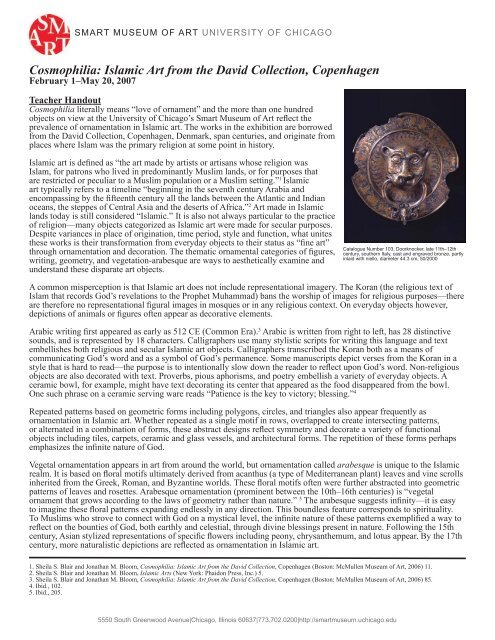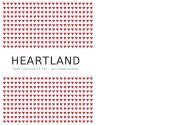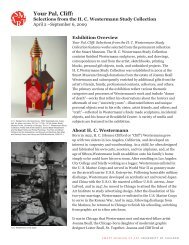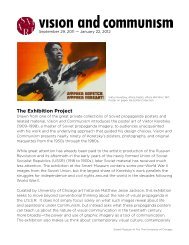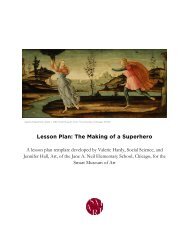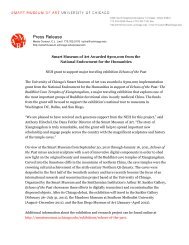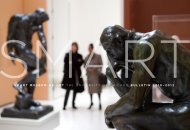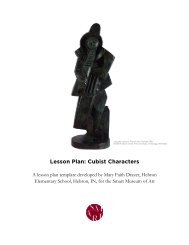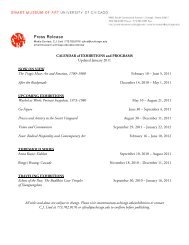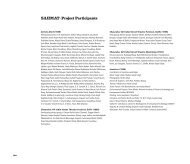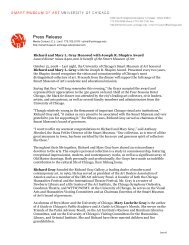Cosmophilia: Islamic Art from the David Collection, Copenhagen
Cosmophilia: Islamic Art from the David Collection, Copenhagen
Cosmophilia: Islamic Art from the David Collection, Copenhagen
You also want an ePaper? Increase the reach of your titles
YUMPU automatically turns print PDFs into web optimized ePapers that Google loves.
SMART MUSEUM OF ART UNIVERSITY OF CHICAGO<br />
<strong>Cosmophilia</strong>: <strong>Islamic</strong> <strong>Art</strong> <strong>from</strong> <strong>the</strong> <strong>David</strong> <strong>Collection</strong>, <strong>Copenhagen</strong><br />
February 1–May 20, 2007<br />
Teacher Handout<br />
<strong>Cosmophilia</strong> literally means “love of ornament” and <strong>the</strong> more than one hundred<br />
objects on view at <strong>the</strong> University of Chicago’s Smart Museum of <strong>Art</strong> reflect <strong>the</strong><br />
prevalence of ornamentation in <strong>Islamic</strong> art. The works in <strong>the</strong> exhibition are borrowed<br />
<strong>from</strong> <strong>the</strong> <strong>David</strong> <strong>Collection</strong>, <strong>Copenhagen</strong>, Denmark, span centuries, and originate <strong>from</strong><br />
places where Islam was <strong>the</strong> primary religion at some point in history.<br />
<strong>Islamic</strong> art is defined as “<strong>the</strong> art made by artists or artisans whose religion was<br />
Islam, for patrons who lived in predominantly Muslim lands, or for purposes that<br />
are restricted or peculiar to a Muslim population or a Muslim setting.” 1 <strong>Islamic</strong><br />
art typically refers to a timeline “beginning in <strong>the</strong> seventh century Arabia and<br />
encompassing by <strong>the</strong> fifteenth century all <strong>the</strong> lands between <strong>the</strong> Atlantic and Indian<br />
oceans, <strong>the</strong> steppes of Central Asia and <strong>the</strong> deserts of Africa.” 2 <strong>Art</strong> made in <strong>Islamic</strong><br />
lands today is still considered “<strong>Islamic</strong>.” It is also not always particular to <strong>the</strong> practice<br />
of religion—many objects categorized as <strong>Islamic</strong> art were made for secular purposes.<br />
Despite variances in place of origination, time period, style and function, what unites<br />
<strong>the</strong>se works is <strong>the</strong>ir transformation <strong>from</strong> everyday objects to <strong>the</strong>ir status as “fine art”<br />
through ornamentation and decoration. The <strong>the</strong>matic ornamental categories of figures,<br />
writing, geometry, and vegetation-arabesque are ways to aes<strong>the</strong>tically examine and<br />
understand <strong>the</strong>se disparate art objects.<br />
Catalogue Number 103, Doorknocker, late 11th–12th<br />
century, sou<strong>the</strong>rn Italy, cast and engraved bronze, partly<br />
inlaid with niello, diameter 44.3 cm, 50/2000<br />
A common misperception is that <strong>Islamic</strong> art does not include representational imagery. The Koran (<strong>the</strong> religious text of<br />
Islam that records God’s revelations to <strong>the</strong> Prophet Muhammad) bans <strong>the</strong> worship of images for religious purposes—<strong>the</strong>re<br />
are <strong>the</strong>refore no representational figural images in mosques or in any religious context. On everyday objects however,<br />
depictions of animals or figures often appear as decorative elements.<br />
Arabic writing first appeared as early as 512 CE (Common Era). 3 Arabic is written <strong>from</strong> right to left, has 28 distinctive<br />
sounds, and is represented by 18 characters. Calligraphers use many stylistic scripts for writing this language and text<br />
embellishes both religious and secular <strong>Islamic</strong> art objects. Calligraphers transcribed <strong>the</strong> Koran both as a means of<br />
communicating God’s word and as a symbol of God’s permanence. Some manuscripts depict verses <strong>from</strong> <strong>the</strong> Koran in a<br />
style that is hard to read—<strong>the</strong> purpose is to intentionally slow down <strong>the</strong> reader to reflect upon God’s word. Non-religious<br />
objects are also decorated with text. Proverbs, pious aphorisms, and poetry embellish a variety of everyday objects. A<br />
ceramic bowl, for example, might have text decorating its center that appeared as <strong>the</strong> food disappeared <strong>from</strong> <strong>the</strong> bowl.<br />
One such phrase on a ceramic serving ware reads “Patience is <strong>the</strong> key to victory; blessing.” 4<br />
Repeated patterns based on geometric forms including polygons, circles, and triangles also appear frequently as<br />
ornamentation in <strong>Islamic</strong> art. Whe<strong>the</strong>r repeated as a single motif in rows, overlapped to create intersecting patterns,<br />
or alternated in a combination of forms, <strong>the</strong>se abstract designs reflect symmetry and decorate a variety of functional<br />
objects including tiles, carpets, ceramic and glass vessels, and architectural forms. The repetition of <strong>the</strong>se forms perhaps<br />
emphasizes <strong>the</strong> infinite nature of God.<br />
Vegetal ornamentation appears in art <strong>from</strong> around <strong>the</strong> world, but ornamentation called arabesque is unique to <strong>the</strong> <strong>Islamic</strong><br />
realm. It is based on floral motifs ultimately derived <strong>from</strong> acanthus (a type of Mediterranean plant) leaves and vine scrolls<br />
inherited <strong>from</strong> <strong>the</strong> Greek, Roman, and Byzantine worlds. These floral motifs often were fur<strong>the</strong>r abstracted into geometric<br />
patterns of leaves and rosettes. Arabesque ornamentation (prominent between <strong>the</strong> 10th–16th centuries) is “vegetal<br />
ornament that grows according to <strong>the</strong> laws of geometry ra<strong>the</strong>r than nature.” 5 The arabesque suggests infinity—it is easy<br />
to imagine <strong>the</strong>se floral patterns expanding endlessly in any direction. This boundless feature corresponds to spirituality.<br />
To Muslims who strove to connect with God on a mystical level, <strong>the</strong> infinite nature of <strong>the</strong>se patterns exemplified a way to<br />
reflect on <strong>the</strong> bounties of God, both earthly and celestial, through divine blessings present in nature. Following <strong>the</strong> 15th<br />
century, Asian stylized representations of specific flowers including peony, chrysan<strong>the</strong>mum, and lotus appear. By <strong>the</strong> 17th<br />
century, more naturalistic depictions are reflected as ornamentation in <strong>Islamic</strong> art.<br />
1. Sheila S. Blair and Jonathan M. Bloom, <strong>Cosmophilia</strong>: <strong>Islamic</strong> <strong>Art</strong> <strong>from</strong> <strong>the</strong> <strong>David</strong> <strong>Collection</strong>, <strong>Copenhagen</strong> (Boston: McMullen Museum of <strong>Art</strong>, 2006) 11.<br />
2. Sheila S. Blair and Jonathan M. Bloom, <strong>Islamic</strong> <strong>Art</strong>s (New York: Phaidon Press, Inc.) 5.<br />
3. Sheila S. Blair and Jonathan M. Bloom, <strong>Cosmophilia</strong>: <strong>Islamic</strong> <strong>Art</strong> <strong>from</strong> <strong>the</strong> <strong>David</strong> <strong>Collection</strong>, <strong>Copenhagen</strong> (Boston: McMullen Museum of <strong>Art</strong>, 2006) 85.<br />
4. Ibid., 102.<br />
5. Ibid., 205.<br />
5550 South Greenwood Avenue|Chicago, Illinois 60637|773.702.0200|http://smartmuseum.uchicago.edu
FIGURES<br />
These three objects represent different time periods (11th–12th century, 9th–10th century, and <strong>the</strong> first half of <strong>the</strong> 17th<br />
century), different parts of <strong>the</strong> world (Egypt, Iran, and India), and depict figures and o<strong>the</strong>r naturalistic forms. Despite <strong>the</strong>se<br />
differences, all contain recognizable images that are somewhat stylized.<br />
Catalogue Number 10, Bowl, 11th–12th century, Egypt,<br />
ear<strong>the</strong>nware painted in reddish-brown luster over<br />
opaque white glaze, 5.5 x 20.5 cm, <strong>David</strong> <strong>Collection</strong><br />
4/1992<br />
Which work uses color to stylize <strong>the</strong> figure?<br />
Which work primarily uses geometry?<br />
Which work uses perspective to stylize <strong>the</strong> figures?<br />
Catalogue Number 18, Box Cover, first half 17th century, Deccan or Sind, India,<br />
wood, painted and lacquered, 20 x 31 cm, <strong>David</strong> <strong>Collection</strong> 56/1999<br />
Bowl, 11th–12th century, Egypt<br />
The figure depicted on this bowl is painted in reserve. The potter first painted <strong>the</strong> fired ear<strong>the</strong>nware bowl with a white<br />
glaze and using <strong>the</strong> glaze silhouetted <strong>the</strong> figure—<strong>the</strong> negative space becomes <strong>the</strong> form. The function and meaning of this<br />
bowl is open to interpretation. The figure appears to drink wine despite this drinking being forbidden in <strong>the</strong> Koran.<br />
Describe <strong>the</strong> details painted on this bowl. What can you tell about this figure?<br />
Do you think this bowl was used for everyday purposes? Why or why not?<br />
Catalogue Number 15, Bottle, 9th–10th<br />
century, Iraq or Iran, colorless glass, height<br />
12.6 cm, <strong>David</strong> <strong>Collection</strong> 3/2000<br />
Box Cover, first half 17th century, India<br />
This wooden box lid is painted and protected with a layer of resin varnish. The men wear turbans and walk alongside<br />
female attendants as <strong>the</strong>y escort a princess riding in an ox-drawn cart. This box may have been owned by <strong>the</strong> princess in<br />
<strong>the</strong> scene.<br />
Describe <strong>the</strong> scene depicted on this box lid. What details do you see?<br />
What do you imagine is happening in this scene? What are <strong>the</strong>se people doing? What might happen next?<br />
The figure in <strong>the</strong> cart is identified as a princess. What do you notice that might make you think she is someone<br />
special? What would you store in such a box?<br />
Bottle, 9th–10th century, Iraq or Iran<br />
This glass bottle was blown and after it had cooled, <strong>the</strong> designs were cut into it. Rabbits are engraved along <strong>the</strong> bottom<br />
of <strong>the</strong> bottle and are alternated with an inscription in an Arabic angular script that reads “blessing.” Often similar vessels<br />
were inscribed with messages that encouraged <strong>the</strong> user of <strong>the</strong> object to have good fortune, happiness, or a long life.<br />
What details did <strong>the</strong> artist include to distinguish this as a rabbit figure?<br />
If you were <strong>the</strong> artisan designing a bottle, what would you choose as an animal symbol for happiness? What would<br />
you choose and an image paired with a message for long life? What do you think this type of bottle was used for?
WRITING<br />
These three works exemplify use as both secular and sacred objects. All however, contain messages written in calligraphic<br />
Arabic script.<br />
Catalogue Number 27, Lamp<br />
Stand, 1470s, western Iran or<br />
eastern Turkey, brass, engraved<br />
and inlaid with silver, height 101<br />
cm, <strong>David</strong> <strong>Collection</strong> 45/1999<br />
Catalogue Number 38, Folio <strong>from</strong> a Koran Manuscript, Ca. 950, Tunisia, gold and<br />
silver on parchment stained blue, 28.6 x 38 cm (trimmed), <strong>David</strong> <strong>Collection</strong> 77/2004<br />
(Side B)<br />
Which works appear to be used for religious purposes? What do you see that makes you think that?<br />
Lamp Stand<br />
This lamp is composed of two parts—<strong>the</strong> base can serve as a candlestick and <strong>the</strong> shaft with <strong>the</strong> bowl-like top serves as an<br />
oil lamp. A pair of lamps (like this one) was used to flank <strong>the</strong> mihrab (niche in a mosque wall that indicates <strong>the</strong> direction<br />
of Mecca, <strong>the</strong> most holy city in Islam) in tombs or shrines. The text on <strong>the</strong> base of <strong>the</strong> lamp is specific to <strong>the</strong> person who<br />
originally had <strong>the</strong> object made. The inscription around <strong>the</strong> top is a poem praising God’s light.<br />
Consider <strong>the</strong> word “illumination” in relation to spirituality and <strong>the</strong> function of this object. How are both a lamp<br />
stand and a spiritual message illuminating?<br />
Folio <strong>from</strong> a Koran Manuscript<br />
This page is <strong>from</strong> a Koran (<strong>the</strong> Muslim Holy Book) manuscript and is written in an angular lettering style of Arabic<br />
script. Ornamentation in <strong>the</strong> form of silver roundels marks <strong>the</strong> ends of verses and function much like a period in English<br />
punctuation. This text urges believers to strive on God’s path.<br />
What artistic choices did <strong>the</strong> calligrapher make to suggest to us that this page is important?<br />
Catalogue Number 29, Bowl, 10th century, eastern Iran or<br />
Central Asia, ear<strong>the</strong>nware covered with a white slip and<br />
painted in brown and red slip under a transparent glaze,<br />
height 10 cm, diameter 26.5 cm, <strong>David</strong> <strong>Collection</strong> 22/1974<br />
Bowl<br />
This bowl contains an inscription in Arabic. The text is decoratively stylized and is written clockwise beginning at <strong>the</strong><br />
position of six o’clock. It reads “He who believes in recompense [<strong>from</strong> God] is generous with gifts.” Four dots mark <strong>the</strong><br />
beginning of <strong>the</strong> sentence—Arabic is read <strong>from</strong> right to left.<br />
In o<strong>the</strong>r words, this text states that someone who thinks he will be repaid, will be more generous. What do you<br />
think is <strong>the</strong> intended message of this text? What does it mean to you? Many ceramic functional vessels contained<br />
proverbs or aphorisms (sayings) about good ways to live life or how to be a better person. What is an aphorism that<br />
you would write as a message to o<strong>the</strong>rs? As an artist, what type of object would be a good to use to convey your<br />
message?
GEOMETRY<br />
These three works reflect <strong>the</strong> variety of symmetrical ornamentation found on textiles, in architectural features, and<br />
metalwork. Sometimes <strong>the</strong> ornamentation is both geometric (made <strong>from</strong> simple polygons and o<strong>the</strong>r shapes) and<br />
naturalistic (resembling organic shapes found in nature).<br />
Catalogue number 45, Fragment of a velvet textile, mid-16th century,<br />
Turkey,silk and metal lamella spun around silk, 95 x 114 cm<br />
<strong>David</strong> <strong>Collection</strong> 25/1962<br />
Catalogue number 46, Screen, Late 16th century, Delhi<br />
region of India,sandstone with openwork decoration,<br />
84 x 53.5 cm, <strong>David</strong> <strong>Collection</strong> 2/1986<br />
Catalogue number 56,Tray, second half 17th century,<br />
Deccan, India, bidri metal inlaid with silver and brass,<br />
diameter 31 cm, <strong>David</strong> <strong>Collection</strong> 16/1987<br />
What elements found in <strong>the</strong>se objects remind you of something organic? What does this shape look like to you?<br />
Identify <strong>the</strong> motif that is repeated to form <strong>the</strong> pattern (What is <strong>the</strong> basic design that <strong>the</strong> artist repeated?).<br />
Fragment of a velvet textile<br />
This Turkish velvet textile is an example of çintamani motif. In Sanskrit, çintamani means “precious jewel.” The origin of<br />
<strong>the</strong> design alludes to three pearls that gave off a mystical flame. By <strong>the</strong> 16th century, this pattern was an important design<br />
of <strong>the</strong> Turkish court.<br />
Elements of this geometric pattern may resemble <strong>the</strong> hides of two different animals. What animal motifs does this<br />
pattern suggest to you?<br />
Screen<br />
This carved stone object served as a screen in a building. It provided some privacy while allowing airflow and light to pass<br />
through. Red sandstone was typically used in palaces and o<strong>the</strong>r buildings, while white marble was used for temples and<br />
religious structures.<br />
The geometric ornamentation in this screen interlocks like a puzzle—<strong>the</strong> shapes overlap and repeat to form <strong>the</strong><br />
pattern. The basic motif however contains a hexagram, a six-pointed star. How many complete hexagrams are<br />
within this screen? How is this screen different <strong>from</strong> screens you are familiar with?<br />
Tray<br />
This tray, made <strong>from</strong> zinc, copper, tin, and lead, is inlaid in silver and brass shapes and probably served as <strong>the</strong> base for a<br />
water pipe (hookah) as part of a smoking set. Geometric ornament radiates <strong>from</strong> <strong>the</strong> center and repeats outward.<br />
The ornamentation on <strong>the</strong> tray actually transforms <strong>the</strong> shape of this object to suggest something representational.<br />
What does it look like to you?
VEGETATION AND THE ARABESQUE<br />
These three objects reflect varied degrees of vegetal ornamentation in <strong>Islamic</strong> art—both those <strong>from</strong> a more<br />
abstract tradition and those depicting naturalistic plants.<br />
Catalogue number 78, Plaque,13th–14th century, Egypt,<br />
carved ivory, 8.2 x 7.9 cm, <strong>David</strong> <strong>Collection</strong>, 48/1978<br />
Catalogue number 86, Panel of Six Tiles,Ca. 1540, Iznik Turkey, fritware<br />
painted in blue, turquoise and sage green with black outlines under a<br />
transparent glaze, 61.2 x 79 cm, <strong>David</strong> <strong>Collection</strong>, Isl. 182<br />
Which work reflects a more abstract design?<br />
Which seems <strong>the</strong> most representational? Why?<br />
Why do you think artists chose to decorate objects with scenes of nature?<br />
Catalogue number 83,Carpet, first half 18th century,<br />
India, Pashmina wool pile on cotton foundation,<br />
166 x 120 cm, <strong>David</strong> <strong>Collection</strong>, Tex. 31<br />
Plaque<br />
This small carved ivory plaque was part of a larger wooden panel that could have been used as a door or as part of a piece<br />
of furniture. The design exemplifies <strong>the</strong> arabesque—<strong>the</strong> stylized plant tendrils are entwined and loop around each o<strong>the</strong>r to<br />
suggest infinite expansion.<br />
This design appears to loop over and under and has depth—it goes back in space to appear three-dimensional. The<br />
artist carved this with a single piece of ivory. How do you think <strong>the</strong> artist achieved this complicated perspective and<br />
design? From what kind of vegetation do you think <strong>the</strong> artist abstracted <strong>the</strong> design?<br />
Panel of Six Tiles<br />
These six naturalistic tiles were created in Iznik, which was <strong>the</strong> center of tile production in Turkey <strong>from</strong> 1299–1922, and<br />
come <strong>from</strong> <strong>the</strong> walls of baths in Istanbul’s Topkapi Palace. Two tiles are paired vertically to complete a representational<br />
image. The artist painted this vegetation in a naturalistic style—it is possible to identify <strong>the</strong> plants depicted. Tulips flank a<br />
center branch of cherry blossoms and a small flowering hyacinth appears in <strong>the</strong> left corner.<br />
The plants painted on <strong>the</strong>se tiles contain details making it possible to identify <strong>the</strong>m. Describe <strong>the</strong> details you see<br />
that help define <strong>the</strong> plant. One of <strong>the</strong> characteristics of <strong>the</strong> truly arabesque is its suggestion of <strong>the</strong> infinite. How<br />
could <strong>the</strong>se tiles suggest infinity?<br />
Carpet<br />
This knotted wool carpet is made <strong>from</strong> <strong>the</strong> fine underhair of <strong>the</strong> Asian domestic goat, which is called pashmina. The carpet<br />
is called a millefleurs type, named for <strong>the</strong> many tiny floral blossoms that make up <strong>the</strong> design. The vegetation on this carpet<br />
appears to grow <strong>from</strong> a single stem held in a vase at <strong>the</strong> bottom of <strong>the</strong> rug. The carpet contains a design that resembles a<br />
mihrab (<strong>the</strong> niche in a mosque wall that indicates <strong>the</strong> direction of Mecca) so it may have been used as a prayer rug with<br />
<strong>the</strong> mihrab pointed toward Mecca, or as a wall hanging.<br />
Millefleurs translates <strong>from</strong> French as “one thousand flowers.” Do you think this is a good title for this type of<br />
carpet? Why or why not? Although <strong>the</strong>re are design elements that contain and frame <strong>the</strong> some of <strong>the</strong> floral pattern<br />
(a border and a mihrab shape) would you still consider this ornamentation as growling endlessly to suggest <strong>the</strong><br />
infinite? Why or why not?
AN EXERCISE IN PATTERN<br />
Sheila Blair and Jonathan Bloom, curators of <strong>Cosmophilia</strong>, describe <strong>the</strong> aes<strong>the</strong>tic of<br />
<strong>Islamic</strong> <strong>Art</strong> as “more is more.” In o<strong>the</strong>r words, unlike modern design, where<br />
sometimes simplicity of surface prevailed, <strong>Islamic</strong> art is layered with pattern and<br />
embellishment. Motifs are often repeated and juxtaposed next to one ano<strong>the</strong>r to<br />
cover <strong>the</strong> entire surface of <strong>the</strong> object.<br />
Using a template of a 12 x 12 inch hexagon shape, invite students to design and<br />
paint a tile using geometric, arabesque, or a purely vegetal design—using a limited<br />
palette (select a palette of four or five colors that each student should use). The<br />
tiles should be exactly <strong>the</strong> same size so <strong>the</strong>y fit toge<strong>the</strong>r to cover a large area. This<br />
project can be executed as a classroom installation—<strong>the</strong> tiles can be arranged<br />
toge<strong>the</strong>r to cover a wall. The tiles may be precut <strong>from</strong> cold-press illustration board<br />
or a heavyweight cardboard. Students may wish to first sketch <strong>the</strong>ir designs in pencil.<br />
If an overall design for a wall of classroom tiles that suggests “<strong>the</strong> infinite”is desired,<br />
it may be helpful to direct students to create a particular “type” of tile and instruct<br />
<strong>the</strong>m to include tendrils that intersect <strong>the</strong> points of <strong>the</strong> hexagon (or some o<strong>the</strong>r<br />
parameter) so each tile’s design connects somehow with <strong>the</strong> o<strong>the</strong>rs surrounding it.<br />
This project can be adapted for elementary–secondary students. Tempera, acrylic,<br />
or gouache will work. If a shiny paint surface is desired to emulate “glaze,” be sure to<br />
use a gel medium to add sheen and extend <strong>the</strong> paint.<br />
Alignment with Illinois Learning Standards and Goals for <strong>the</strong> Visual <strong>Art</strong>s<br />
Docent-led tours of <strong>Cosmophilia</strong>, related discussion in <strong>the</strong> Museum or classroom, and an exhibition inspired classroom<br />
hands-on activity (such as one suggested above), reinforce elements of <strong>the</strong> Illinois standards and goals for <strong>the</strong> visual arts<br />
by encouraging students to recognize and solve artistic problems, express and interpret information and ideas, work as<br />
a team as part of a larger group hands-on project, and make connections between <strong>the</strong> visual arts and o<strong>the</strong>r disciplines<br />
(history, social studies, language arts).<br />
STATE GOAL 25: Know <strong>the</strong> language of <strong>the</strong> arts.<br />
A. Understand <strong>the</strong> sensory elements, organizational principles and expressive qualities of <strong>the</strong> arts.<br />
B. Understand <strong>the</strong> similarities, distinctions and connections in and among <strong>the</strong> arts.<br />
STATE GOAL 26: Through creating and performing, understand how works of art are produced.<br />
A. Understand processes, traditional tools and modern technologies used in <strong>the</strong> arts.<br />
B. Apply skills and knowledge necessary to create and perform in one or more of <strong>the</strong> arts.<br />
STATE GOAL 27: Understand <strong>the</strong> role of <strong>the</strong> arts in civilizations, past and present.<br />
A. Analyze how <strong>the</strong> arts function in history, society and everyday life.<br />
B. Understand how <strong>the</strong> arts shape and reflect history, society and everyday life.<br />
Catalogue number 57, Hexagonal Tile,Ca. 1400, Central Asia<br />
ear<strong>the</strong>nware painted with gold and colors, diameter 30.2 cm,<br />
<strong>David</strong> <strong>Collection</strong>, 48/2001<br />
About <strong>the</strong> <strong>David</strong> <strong>Collection</strong> and <strong>the</strong> exhibition<br />
Christian Ludvig <strong>David</strong> (1878–1960) was a private collector of <strong>Islamic</strong> and o<strong>the</strong>r arts who studied and practiced law in<br />
<strong>Copenhagen</strong>, Denmark. His collecting habits formed what is now known as <strong>the</strong> <strong>David</strong> <strong>Collection</strong> in <strong>Copenhagen</strong>. There<br />
are approximately 2,555 objects (as of 2005) in this collection. <strong>Cosmophilia</strong> was curated by professors Sheila S. Blair<br />
and Jonathan M. Bloom, Norma Jean Calderwood University Professors of <strong>Islamic</strong> and Asian <strong>Art</strong> at Boston College. This<br />
traveling exhibition was initiated in part by <strong>the</strong> Director of <strong>the</strong> <strong>David</strong> <strong>Collection</strong>, Kjeld von Folsach. With <strong>the</strong> temporary<br />
closing of <strong>the</strong> <strong>David</strong> <strong>Collection</strong> in May 2006 for reorganization, remodeling of galleries, and reinstallation of <strong>the</strong><br />
collection, Blair and Bloom proposed borrowing select works <strong>from</strong> <strong>the</strong> <strong>David</strong> <strong>Collection</strong> for an exhibition that examines<br />
<strong>Islamic</strong> art in relation to <strong>the</strong> over arching <strong>the</strong>me of ornamentation. This exhibition originated at <strong>the</strong> McMullen Museum of<br />
<strong>Art</strong>, Boston College. The University of Chicago’s Smart Museum of <strong>Art</strong> is its final traveling venue in <strong>the</strong> United States.


